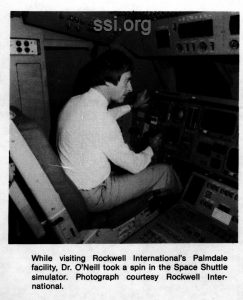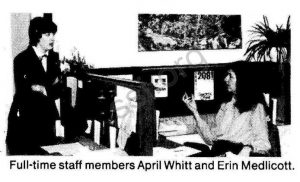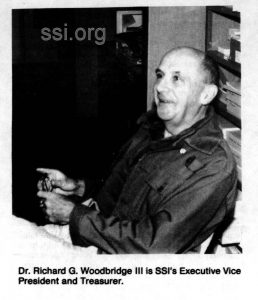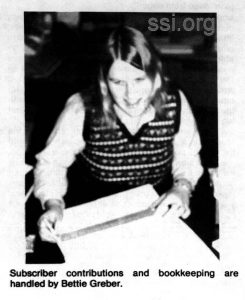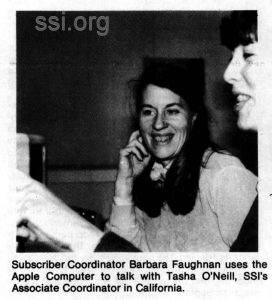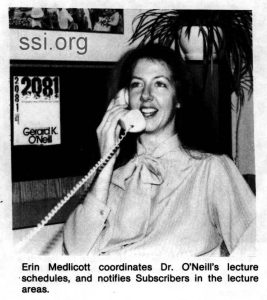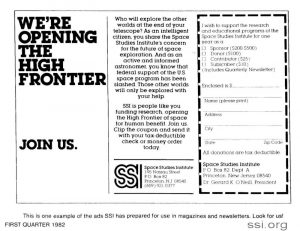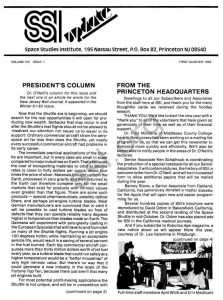
SSI UPDATE
Space Studies Institute
195 Nassau Street
P.O. Box 82
Princeton, NJ 08540
[[librarian note: This address is here, as it was in the original printed newsletter, for historical reasons. It is no longer the physical address of SSI. For contributions, please see this page]]
VOLUME VII ISSUE 1
FIRST QUARTER 1982
PRESIDENT’S COLUMN
Dr. O’Neill’s column for this issue and the next one is an article he wrote for the New Jersey Bell Journal. It appeared in the Winter 81-82 issue.
Now that the Shuttle era is beginning, we should search for the real opportunities it will open for producing new wealth. Setbacks that may occur in and after the Shuttle’s test flights should not be allowed to misdirect our attention nor cause us to waver in its support. Ordinary commercial aircraft strain the aerospace art far less than does the Shuttle, yet nearly every successful commercial aircraft had problems in its early career.
The immediate practical applications of the Shuttle are important, but in every case are small in scale compared to major industries on Earth. That’s because the cost of transporting materials to orbit at Shuttle rates is close to forty dollars per ounce, about four times the price of silver. Materials brought up from the Earth, processed in zero gravity and then returned to the Earth can therefore compete only for the small markets that exist for products with intrinsic values even greater than that figure. There are some such products – special pharmaceuticals, possibly optical fibers, and perhaps jet-engine turbine blades. West German manufacturers are convinced that in orbit it will be possible to cast turbine blades so free of defects that they can operate reliably many degrees higher in temperature than blades made on Earth. The Germans will experiment with zero-gravity casting in the European Space lab that will travel to and from orbit on many of the Shuttle flights. Running a jet engine 100 degrees hotter, while maintaining an acceptable service life, would result in a saving of several percent in the fuel burned. Each big commercial aircraft consumes more than thirty million dollars worth of jet fuel every year, so a turbine blade that could run safely at a higher temperature would be a “better mousetrap” of very high intrinsic value. But there’s no way that it could generate a new industry in the scale of the Fortune Top Ten, because there just aren’t that many jet engines built.
For most potential profit-making applications the Shuttle is not unique, and will be in competition with launch vehicles made by other nations. The Arianespace corporation, a venture supported by several European governments, has been set up in direct competition with the Shuttle for the launch of satellites, and man-rated versions of the Ariane launch vehicle are already under discussion. The Japanese, who have had several space programs with launch capability for more than a decade, have recently decided to push for still greater independence: they’ll manufacture their future rockets exclusively in Japan rather than buying components from the U.S.A..
But there is one commercial possibility, never so far discussed, for which the Shuttle would be truly unique: the transport of passengers to and from orbit. It would be quite possible and not very expensive to fill the Shuttle’s cargo bay with passenger seating adequate for the 20-minute flights to and from an orbital space station. The bay is as large as the cabin of many widebody airliners, and within Shuttle payload constraints could carry as many as 250 to 325 passengers. If someone with the enterprise of a Conrad Hilton or a Freddie Laker were to seize that opportunity, we could have by the 1990’s an orbital station combining several attractions that would be totally unique: the delicious physical freedom of zero gravity, spectacular views of Earth from multiple round-the-world trips at low orbital altitude, and dazzlingly clear visions of the universe through telescopes unblurred by the atmosphere. For educational vacations of two weeks or so, the facility could also offer the best of gourmet meals and fine wines. If even one Shuttle orbiter were to be bought and fitted out as a charter spaceliner to serve that station, more than 8,000 people every year could make the trip. Many young people I know would be more than willing to live simply for five or ten years while they saved $10,000 dollars a year in anticipation of that once-in-a-lifetime experience. And many older people would take that opportunity rather than paying for just one more luxury-class world cruise or global air tour. As for the space-station, it could be built inexpensively because of another unique characteristic of the Shuttle: the fact that on each of its flights into space it carries almost to orbit an external fuel tank, far larger than the Shuttle orbiter and weighing more even when empty than the entire Shuttle payload. Studies made by NASA show that the external tank could be brought to orbit at an insignificant sacrifice in the Shuttle payload weight – and most Shuttle flights will be limited not by weight but by cargo volume. Two of the external tanks could be tied together by steel cables and set to rotating slowly, to make normal Earth gravity inside them for dining and other one-gravity areas. Other could be fitted out as zero-gravity facilities.
As for potential new production industries in space, they too must live within the Shuttle system constraints if they are to be practical. We’ve only barely begun to use the Shuttle, so this is no time to base plans on a still more advanced vehicle. The Shuttle will be seriously under-utilized according to present NASA projections, with no more than 20 to 40 flights made each year. Only when the Shuttle fleet is operated like airline equipment, with fast turnaround and high utilization, can it turn a profit. The Shuttle was designed for a turnaround time of two weeks for each Orbiter, or about 25 trips per year. When every Orbiter is flying such a schedule, and when the fleet has risen to at least ten vehicles, we can say that the Shuttle system is being used effectively. With those figures the annual operating revenue and the total capital investment in the fleet would each roughly equal the Shuttle’s development costs. At any lower utilization rate the Shuttle would remain badly unprofitable, like a commercial airplane that never succeeded in pentrating its market.
Fortunately, the Shuttle system is rich in growth capability. Test data from the first flights indicate that though specific weak points may be found, the Shuttle as a system is (quite properly) somewhat overdesigned. Its external heat-shield tiles run cooler than expected, its fuel tank is stronger than need be, and the Orbiter’s ability to bring loads safely back from orbit can rise as the uncertainties in its calculated performance charts are replaced byactual data points. Future landings will be flown routinely by the on-board computers, which are gentler, smoother and less stressful to the vehicle than even the immensely talented and superbly trained Astronaut pilots.
Growth versions of the Shuttle could be built without the need for redesigning any of its more expensive systems. For flights carrying heavy freight into orbit, the Orbiter could be replaced by a simple cargo shroud, riding on top of a cluster of three main engines, essentially the aftmost portion of an ordinary Orbiter fuselage. In that way close to 100 tons of freight could ride to orbit, compared with only 29 tons of payload in an Orbiter payload bay. The engines could be recovered most simply by returning them as “space-available” cargo on Shuttle flights homeward bound from delivering satellites to orbit. And for all Shuttle flights, whether of the Orbiter vehicle or its cargo derivative, costs can be reduced a great deal if the solid rocket boosters are replaced by reusable liquid-fueled strap-on rockets. The Saturn-5 booster rockets of the Apollo era were fuelled by kerosene and liquid oxygen, far cheaper than the exotic mixture of synthetic rubber and aluminum powder in the present solid rockets. NASA and its contractors have already studied the replacement of the solids by conventional “LOX-Kerosene” rockets, and when the Shuttle system begins to be used often enough to justify modest new development costs, those solid rockets will be candidates for replacement. Liquid fuel exhausts will also be far less polluting to the atmosphere than the combustion products of the solids. Given these possibilities, it seems likely that Shuttle freight rates will drop to about half their initial cost for cargo carried in the Orbiter, and to about one sixth present rates for one-way upward-bound cargo on freight-only flights.
The new possibilities in space with really big potential payoff all exploit a fact of nature that’s never been used so far: the cost in energy to lift a ton of material from the Moon to high orbit is less than a twentieth as much as to bring a ton from the Earth to the same place. That fact could be the basis for a first simple use of nonterrestrial materials. Lunar soils, compacted into spheres, can be lofted to a precise point in high orbit by an electric catapult on the Moon called a “mass-driver.” The lunar material can then be packed around high-orbital space stations to shield them against cosmic rays. For shielding, a ton of unprocessed lunar soil is just as good as a ton of any material from the Earth. A solar-powered mass-driver, lifted to low orbit by the Shuttle and then transferred to lunar orbit and landed by smaller rockets, would be able to export lunar material for only half a dollar per ounce, the cost being almost entirely the writeoff on the mass-driver’s development investment. That would be only about one percent of the cost of bringing equal tonnage to high orbit from the Earth, even with the most advanced derivative of the Shuttle for the first leg of the trip.
Once we bring materials to high orbit from the Moon with a mass-driver, we can separate them into their useful pure elements. The first of these is oxygen, the most plentiful element on the Moon (it is 40% by weight in an average shovelful of lunar dirt). Oxygen constitutes most of the weight of propellant for any liquid rocket, so it is truly the “gasoline of space,” and will be a valuable product saleable to every nation’s space program. At Shuttle freight rates oxygen in orbit costs about $3,600 per gallon, so any venturesome company that can beat that price can corner the market variously estimated as 200,000 to two million gallons per year, even in a conservative estimate for near term propellant demand in space.
(to be continued in next issue)
FROM THE PRINCETON HEADQUARTERS
Greetings to all our Subscribers and Associates from the staff here at SSI, and thank you for the many thoughtful cards we received during the holiday season.
THANK YOU!
We’d like to start the new year with a “thank you” to all of the volunteers that have given so generously of their time as well as of their financial support.
Dr. Fred Montana of Middlesex County College here in New Jersey has been working on a mailing list program for us, so that we can get this newsletter to everyone more quickly and efficiently. We’ll also be better able to notify people in the areas of Dr. O’Neill’s lectures.
Senior Associate Ken Schalhoub is coordinating the production of a special notebook for all our Senior Associates. It will contain pictures, the history of SSI, a welcome letter from Dr. O’Neill, and will be in looseleaf form to allow additional papers that will be mailed during the year.
Barney Stone, a Senior Associate from Oakland, California, has generously donated a master diskette for the Apple that will open new and easier programming for us.
Several hundred copies of SSI’s brochure were reproduced by David Odom in Bakersfield, California, and distributed at the second landing of the Space Shuttle in mid-October. Dr. Odom has also placed ads for SSI in the California medical journals.
And if you subscribe to Robotics Age magazine, a new notice about us will appear there this year, courtesy of Dr. Lee Valentine in Pittsburgh.
Thank you to all of them, and to all of you handing out brochures at local space-Interest meetings, writing letters to Senators and Representatives, offering expertise In computers, and supporting SSI In the unglamorous jobs of envelope stuffing and poster hanging.
If you’re interested In volunteering a service, send us a note. Sometimes we can’t use a skill immediately, but in the coming weeks and months of this year we could contact people for help with lectures and special meetings. And If you want to place an ad for new Subscribers In a magazine or newsletter, SSI has developed several sets of graphics and Information, camera-ready for an editor to use In a layout.
Send us the name of the publication, Information about Its circulation and readers, Its size requirements, and a sample copy.
MASS-DRIVER RESEARCH:
Dr. O’Neill’s schedule calls for the period July 1981-early 1982 to be devoted to the design of the new Mass-Driver III, which he is carrying out himself using the “SSI West” Apple computer. During that time the Mass-Driver Lab, in Princeton’s Jadwin Hall about half a mile from SSI, Is empty, ready to receive the new mass-driver model which is to be built as an outside contract Item. Dr. O’Neill’s report, intended for people with technical knowledge in electromagnetics and computers, follows:
“In the new Mass-Driver III program I’m designing the accelerator fully by computer prior to construction. There are no approximations except for stepwise integrations and the concentration of coll currents into thin filaments. With each time-step used, twenty new mutual inductances (i.e. from bucket coll to each of 20 drive coils) are recalculated from the elliptical integrals. The direct interaction between drive coils can be expressed as a vector of 20 elements. There are two alternative ways of doing the hardest part of the calculation: one can either invert a 21 by 21 matrix for each time-step, or one can perform successive approximations In terms of the 39 mutual inductances until all voltages and current rates-of-change satisfy 21 simultaneous differential equations. So far I’m using the second method, but to keep the options open I’d appreciate information on a good fast matrix-inversion subroutine that can run on an Apple computer.”
“For speed of programming, I’m using the Applesoft Command Editor software package from Southwestern Data Systems. For speed of calculation I’m using the TASC Compiler from Microsoft, Inc. My program is fairly long, and takes about 15 minutes to compile. However, once compiled Into machine language it runs about six times faster than the Applesoft Source Code. I’m quite pleased with the progress and am having a lot of fun with the problem; however I’ve done eough programming to know better than to say when it will all work perfectly. My intention is to have Mass-Driver III built as a jobshop Item by a coil winding company, according to the computer generated design. The hookup, testing and debugging of the machine will be done in the Mass-Driver lab at Princeton, and will require our activating that lab no later than September of this year.”
CHEMICAL PROCESSING RESEARCH:
Rockwell International and CalSpace Institute have encountered some delays, and have requested of SSI (and been granted) a no-cost extension of time to complete their work. SSI’s Chemical Processing Review Committee monitors Rockwell’s monthly progress reports, and returns information to SSI which is incorporated in review summaries that we send to Rockwell and CalSpace to assist and guide their work. As expected, much new information about reaction rates and physical chemistry has come out of the SSI sponsored research. So far Rockwell and CalSpace have not run into any snags that they couldn’t find ways around.
JOB OPPORTUNITY:
As the activation of the Mass-Driver Laboratory is not required earlier than September 1982, we have so far not filled the position of laboratory supervisor and primary associate of Dr. O’Neill in the mass-driver work. His preference is to fill that position at the Ph.D. level, preferrably in physics or applied physics. Applicants for the position should apply to Mr. V. Richard Boscarino, Personnel – Physics Department, Princeton University, P.O. Box 708, Princeton, New Jersey 08540.
NEW TAX LAWS:
Under new tax laws, people who do not itemize their tax forms will be allowed increasing deductions for gifts to charities over the next five years. You may want to check with a local tax lawyer, or write to SSI for the figures. If you’ve considered becoming a Senior Associate of SSI (a senior Associate pledges a sum per year for a five-year period, now may be an advantageous time to join that program.
LOCAL CHAPTERS:
Supporters in the Miami, Florida area are invited to contact David Lorr for information about forming a Local Chapter. Mr. Lorr has graciously volunteered his name and address: David Lorr, xxxxxxxxx, Miami, Florida, 33133; telephone (xxx)xxx-xxxx. If you’re in the Orlando/Winter Park area, Loren Curro is looking for interested members for a potential chapter: Loren Curro, xxxxxxxxxxxxxxxxxx, Orlando, Florida, 32806. And Mark Nemzek, in New Hope, Minnesota, has also volunteered to be a contact person: Mark Nemzek, xxxxxxxxxxxxxx, Minnesota, 55428; telephone (xxx) xxx-xxxx.
LECTURES:
With the flights of the Shuttle last year, and particularly with the publication of 2081, the requests for Dr. O’Neill’s lectures have risen to an all-time high. In December 1981 he had to establish a policy of declining all new requests for the ’81 – ’82 academic year, in order to leave time for his research. Requests for Dr. O’Neil’s lectures may be made through the SSI office, for dates no earlier than July 1982.
Dr. O’Neill’s Spring 1982 lecture schedule follows. Lectures marked with an asterisk (*) are closed to the public.
February
February 8 -American Bankers Association*, New Orleans, LA.
February 10 -Embry-Riddle Aeronautical University, Daytona Beach, FL.
February 11 -Florida Institute of Technology, Melborne, FL.
February 23 -Lawrence University, Appleton, WI.
February 24 -University of North Dakota, Grand Forks, ND.
March
March 16 -I.B.M.*, Miami, FL.
March 19 -1.B.M.*, Miami FL. (morning)
March 19 -Tulane University, New Orleans. LA. (evening)
March 23 -I.B.M.*, Miami, FL.
March 24 -Main Line Forum*, Philadelphia, PA.
March 26 -I.B.M.*, Miami, FL.
March 29 -Creighton University, Omaha, NE.
April
April 1 -I.B.M.*, San Francisco, CA.
April 21 -Broward College, Ft. Lauderdale, FL.
April 29 -I.B.M.*, Bermuda.
May
May 4 -I.B.M.*, Bermuda
May 7 -I.B.M.*, Bermuda
THE HIGH FRONTIER:
Many friends of SSI have asked when Dr. O’Neill’s “The High Frontier” would be in publication again. There has been a long delay because the paperback publisher only relinquished the rights to the book in January 1982. A winning offer has been made for publication of “The High Frontier” as a high-quality “trade” paperback by a major publishing house, and we will announce the publisher and publication date when the contract has been signed.
A set of 16 color slides and descriptions of space colonies and space manufacturing is available for $15.00 through SSI.
For gift giving we now have an attractive person· alized card for your gift subscriptions. For each gift enclose the name to be placed on the card and the address to where it should be sent along with your donation.
I wish to support the research and education programs of SSI for one year as a:
[ ] Sponsor ($200-$500)
[ ] Donor ($100)
[ ] Contributor ($25)
[ ] Subscriber ($10)
[ ] This is a renewal
[ ] New Address
Name:
Address:
City, State, Zip:
(Canadian Subscribers kindly remit in U.S. funds via postal money order/bank draft)
-All Donations are Tax Deductible
SSI, P.O. Box 82, Princeton, NJ 08540
[[librarian note: This address is here, as it was in the original printed newsletter, for historical reasons. It is no longer the physical address of SSI. For contributions, please see this page]]
©space studies institute

